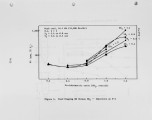| OCR Text |
Show Figure 7 also shows the advanced air staging* exit NO variation for different first-stage residence times at fixed second-stage residence times. Comparing in figure 7, the SRj = 0.8 advanced air to SR2 =0.9 fuel-staging NO results at 0.33 sec fuel-rich stage residence time, it can be seen that fuel staging has better NO performance than air staging for low fuel-rich-stage residence times. The air-staging results are about 50 percent higher than the fuel-staging results at less than 0.33 sec residence time. Fuel Fraction Most of the fuel-staging data was taken at a fuel fraction of unity (f • 1), where equal amounts of fuel were injected into the first and second stages. This f value was chosen as the nominal condition because the effect of fuel staging was expected to be significant and easy to see at this condition. Also, a very large range of first- and second-stage stoichiometry combinations could be explored. For higher fuel fractions, where less fuel is injected into the second stage, transport air requirements limited the range of stoichiometries which could be achieved. In addition to the f • 1 case, an f • 3 case was extensively tested. Figure 8 compares f = 3 (75 percent of the fuel in the first stage) and f = 1 (50 percent of the fuel in the first stage) NO results for the nominal-stage-length F-J injector location (see figure 3). At low SR2 the NO emissions for f = 3 are roughly independent of SR^ and are at about the same level as for f • 1. As SR2 increases, NO emissions are less for f • 3 than for f = 1 under fuel-rich, first-stage conditions. Under fuel-lean, first-stage conditions (SR| >^ 1), NO emissions are comparable for f • 1 and f • 3. The comparability of f • 3 and f • 1 emissions for lean SR| is encouraging evidence that for the fuel-staging conditions of interest *Air staging with air added at stations b and c (see figure 3). 8-17 |


























